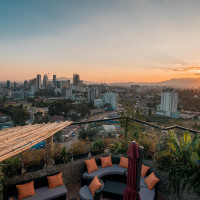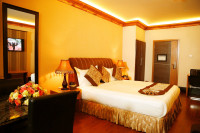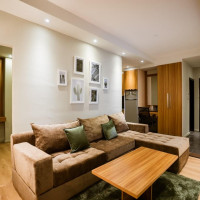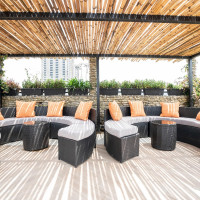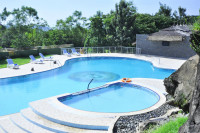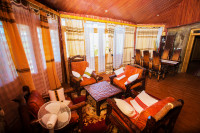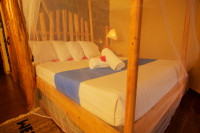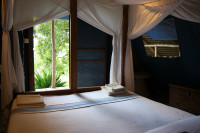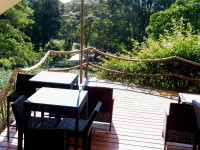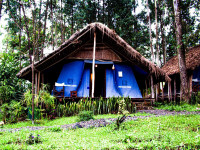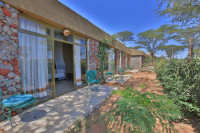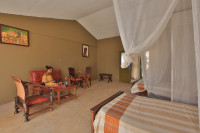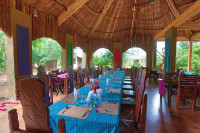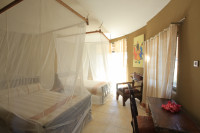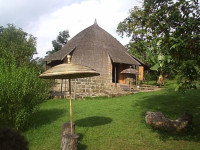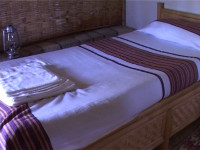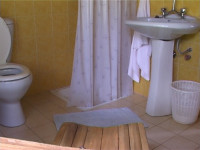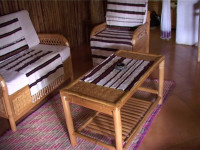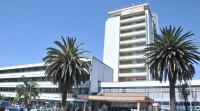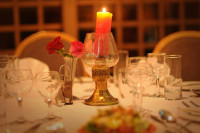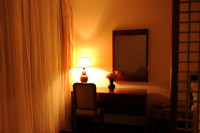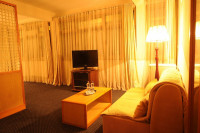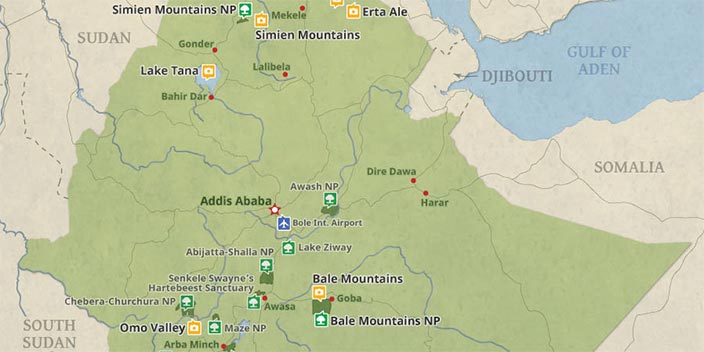
$1,539 pp (USD)
This tour is offered in EUR.
Show rate in EUR
Arrival
Arrival

Day 1
Arriva to Addis Ababa and Make City Tour
Arriva to Addis Ababa and Make City Tour
Upon your arrival at Bole International Airport and you will clear immigration and pass through the arrivals hall where you will be met by an FTE representative, who will assist you with your transfer to your hotel.
After a break, you will enjoy a half-day guided tour of the Ethnological Museum, with its artifacts and displays of the cultures and handicrafts of Ethiopia’s many ethnic groups. At the famous National Museum, with its cultural and archaeological relics, you will visit the famous “Lucy,” a 3.2 million-year-old female hominid who was discovered in Ethiopia’s Awash Valley in 1974. Time permitting; you may visit the biggest open-air market of Addis Ababa, the Mercato, is the largest on the continent, and you will take a drive through it. You may also visit Ba'ath Church, also known as Menelik’s Mausoleum, one of the oldest of the churches in Addis, built-in 1911. It houses beautiful paintings and the royal tombs of past emperors, including Emperor Haile Selassie.
- Main Destination:
- Addis Ababa (City)
- Accommodation:
- Monarch Parkview Hotel
- Meals & Drinks:

Day 2
Drive Addis Ababa to Ariba Minch
Drive Addis Ababa to Ariba Minch
The morning after breakfast, start driving down to the south, drive southward to the rift valley regions. On the way to visit, Adadi Mariam is a subterranean rock-hewn church similar to those of Lalibela. This church is unique as it is the southern-most church of its type, and stands alone – no other rock-hewn churches are in the area. While it dates to around the same time as the Tiya stelae and is only 30km north of them, Adadi Mariam provides a strong contrast to the pagan-like aura at Tiya. Before arrival, you will drive 40kms northwest of Arba Minch to Guge Mountains to visit the Dorze and Chencha villages. Once warriors, the Dorze have now turned to farming and weaving to earn a living. The “elephant huts” of the Dorze are unique and worth seeing. Also, the Dorze beehive-shaped houses are constructed entirely of organic material and have their own small garden surrounded. Some of Ethiopia’s best-woven cotton comes from Chencha, which is located 8 km northwest of Dorze Village.
- Main Destination:
- Arba Minch (City)
- Accommodation:
- Paradise Lodge
- Meals & Drinks:

Day 3
Drive to Jinka via Konso and Key Afer
Drive to Jinka via Konso and Key Afer
After breakfast, you will have a boat trip on the blue waters of Lake Chamo to see the crocodiles, hippos & aquatic birdlife. The northern shores of Lake Chamo are famous for their large crocodiles, which can be seen in great numbers lounging in the heat. Then you will drive to Konso where colorfully costumed dress, impressive terracing of the Land and unusually engraved wooden statues used as grave markers can be seen. Differing from their neighbors, the Konso are pure agriculturists, famed for their use of the stone terraces that they utilize to such good effect in this dry and barren region of basalt hills. Keep driving to Key Afer for the colorful Thursday market the Ari, Bena, Hamer, and Tsemay people. The Bena and Hamer women usually favor red clay braids in their hair. The long beaded skirts of the Tsemay have a stick incorporated in the back to denote a married woman and the men have elaborately plaited hairstyles decorated with feathers. After visiting, we drive on to Jinka.
- Main Destination:
- Jinka (Lower Omo Valley)
- Accommodation:
- Eco Omo Lodge
- Meals & Drinks:

Day 4
Visit the Mursi tribes in Mago National Park drive Turmi
Visit the Mursi tribes in Mago National Park drive Turmi
Early morning drive to Mago National Park, from here, visit the Mursi highlands where the most illustrious of Ethiopia’s unique tribes live. The Mursi are known all over the world, for their decorative lip plates that adorn the lower lips of the Mursi women. The plates stretch the lower lip beyond imagination and the women’s beauty, pride, and desirability is determined in direct proportion to the size of the plate. The Mursi men and women may appear gracious but the Mursi warriors are not to be sneezed at. On their arms are deep crescent incisions that represent each enemy they have killed in battle. The men are also famous for their hairstyle. The various cultural aspects of the tribe will be explained and you will be able to take their photographs but not for free. Back to Jinka for your lunch and afternoon go to the Ari Village nearby the town of Jinka for experiencing and learning the culture of the Ari tribe. In the afternoon we continue our driving to Turmi via Dimeka.
- Main Destination:
- Turmi (Lower Omo Valley)
- Accommodation:
- Emerald Lodge Turmi
- Meals & Drinks:

Day 5
Visit Karo and the Hamer Tribes
Visit Karo and the Hamer Tribes
Early in the morning after breakfast, we start to drive to Karo. We arrive at Korcho village with beautiful views over the Omo River to see the Karo ethnic group, experts in body painting, using clay and locally available vegetable pigments to paint fantastic patterns on each other’s faces, chests, arms, and legs. After lunch, you will visit the Hammer Tribe near Turmi. The Hamer tribe is one of the largest groups in the Valley. The Hamer cultivate millet, vegetables, tobacco, and cotton as well as raising cattle and goats. They are known for the fine pottery they produce as well as their remarkable hairstyling. Most dramatic of all are the clay hair buns with ostrich feathers that the men don when they have killed a fierce animal. The Hamer women are simply stunning. The women wear beaded necklaces and iron coils around their arms and decorate their skin with cowry shells. These decorations indicate the wealth and prestige of a woman’s husband.
- Main Destination:
- Turmi (Lower Omo Valley)
- Accommodation:
- Emerald Lodge Turmi
- Meals & Drinks:

Day 6
Excursion to Omorate and Drive to Konso
Excursion to Omorate and Drive to Konso
This morning we start driving south to Omorate to visit another tribe, the Dasenech (formerly known as Geleb), and one of their villages. These people inhabit the areas bordering Kenya, north of Lake Turkana, and they live on the east and west bank of the Omo River. They are agro-pastoralists and herd cattle and practice flood retreat cultivation on both sides of the river. The Celeb Covering a large territory, the Geleb live along the western banks of the Omo River, having been forced out of the Turkana region by conflict in the 18th century. Originally nomadic pastoralists, the more fertile surroundings of the Omo River have caused them to put down more permanent roots based around fishing and agriculture. The Celeb live in small huts that befit their nomadic origins, as they could be easily and quickly dismantled. Women wear pleated cowskin skirts with necklaces and bracelets. Men wear a checkered cloth around their waist only. After lunch, we drive to Konso overnight.
- Main Destination:
- Konso (Cultural Village)
- Accommodation:
- Kanta Lodge
- Meals & Drinks:

Day 7
Drive to Yirgalem
Drive to Yirgalem
Today we drive to Yiregalem over the beautiful Sidamo mountains and coffee plantation. On the way, we stop at Wenago to visit the Tutu Fella stelae field – an unusual collection of carved stones. Little is known about the origin of these stelae or the reason for their erection, though it is thought that they date from the 9th century. This is a driving day to make it to our traditional Sidamo-style lodge. We can take a short walk in the late afternoon through the lovely natural ecosystem and admire the Sidama Coffee farm.
- Main Destination:
- Yirgalem (Town)
- Accommodation:
- Aregash Lodge
- Meals & Drinks:

Day 8
Drive to Bale Mountain National Park
Drive to Bale Mountain National Park
This morning, we will go to experience local's life at the daily fish market on the lakeshore. It is also a great place to spot a great number of water birds, especially the African marabou storks. Later, we will drive 6 hours to the headquarter of Bale Mountains National Park. Many wild animals around the headquarter like Mountain Nyala and Minilik Bushbuck have gotten quite used to humans. So it is one of the few regions in this park where you could walk among animals. Next, we will go on driving to the lodge located 100 km (62 mi) away and check-in before nightfall.
- Main Destination:
- Bale Mountains National Park
- Accommodation:
- Goba Wabe Shebelle Hotel
- Meals & Drinks:

Day 9
Full day Safari in Bale Mountain National Park
Full day Safari in Bale Mountain National Park
Today we will tour around the Bale Mountains National Park! The national park covering an area of 2,200 square kilometers (1,370 square miles) comprises grasslands, woodlands, meadows, and swamps, and moorlands inhabited by a great variety of rare endemic animals like Ethiopia wolves, Bale monkey, giant forest hogs, and some of Rift Valley's most threatened bird species. In the morning, we will go on safari at the region of Hrenna Forest, where you could see plenty of Ethiopian endemic birds, mammals, and amphibious. Then we will move to Sanetti Plateau and have a picnic lunch there. In the afternoon, hike along the top of the peak over the plateau in search of the endangered Ethiopian wolves and get close to other African animals.
- Main Destination:
- Bale Mountains National Park
- Accommodation:
- Wabe Shebelle Hotel Addis Ababa
- Meals & Drinks:
Day 10
Drive Back to Addis Ababa and Departure
Drive Back to Addis Ababa and Departure
Today you will return to Addis Ababa. On the way, visit the Abijatta-Shala National Park. Lake Shala is a very deep crater lake (over 260 meters deep!) and Lake Abijatta is a soda lake, which attracts thousands of flamingos. After the visit, continue driving back to Addis Ababa. In the evening, farewell party dinner invitation by FTE with cultural dinner and traditional special buffet and local drinks to experience Ethiopia’s cultural meals and drinks. Here you will enjoy and experience several tribal dances. After the farewell dinner party, we transfer you to Bole International Airport for international departure.
NOTE: The tour program can modify differently, rearranged, combined with other itineraries, and shorten or extended to suit your interest, time, and budget. Upon request, FTE can arrange various tour programs based on your interest.
- Main Destination:
- No major destination visited
- Accommodation:
- No accommodation (End of tour)
- Meals & Drinks:


